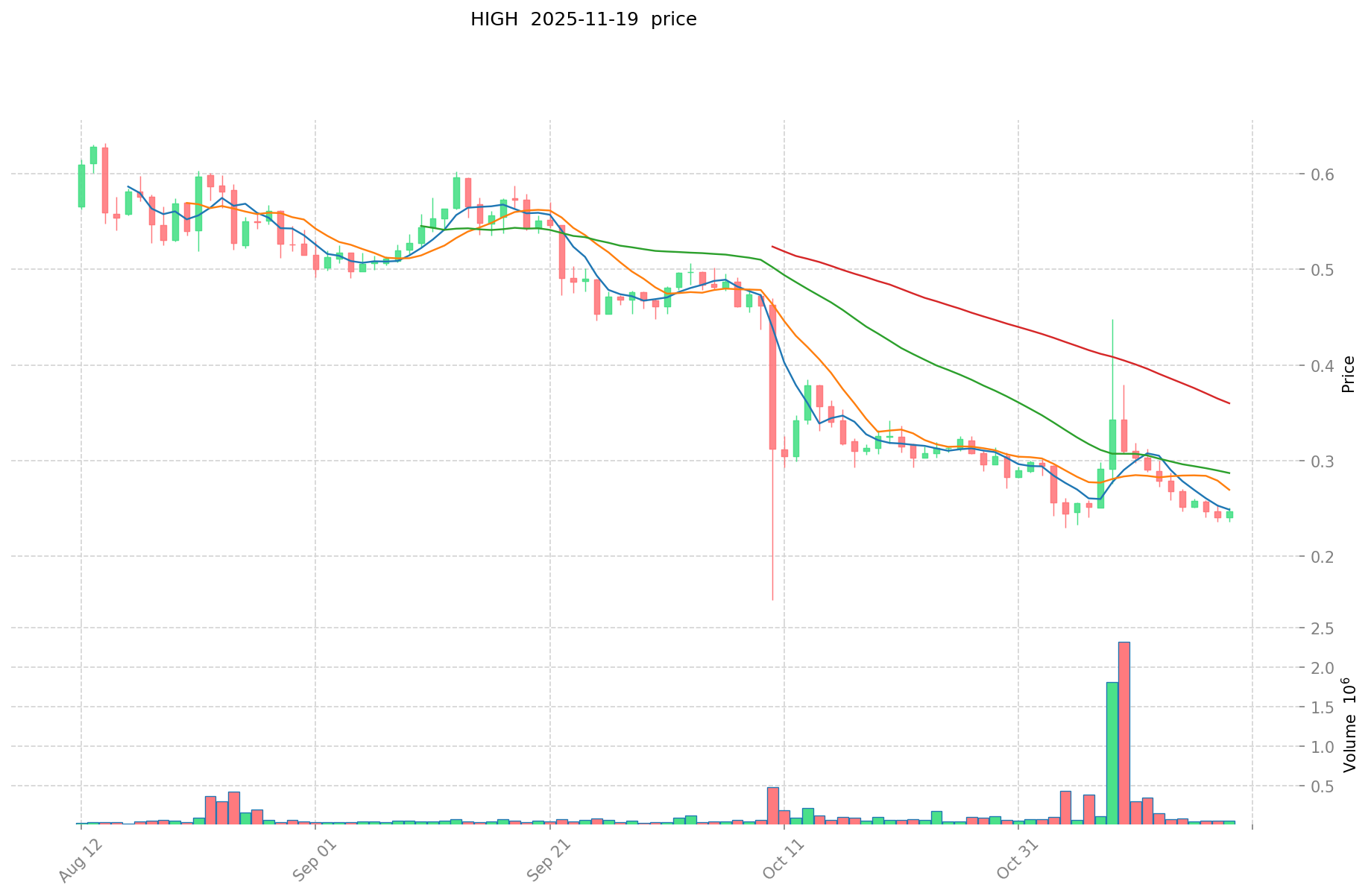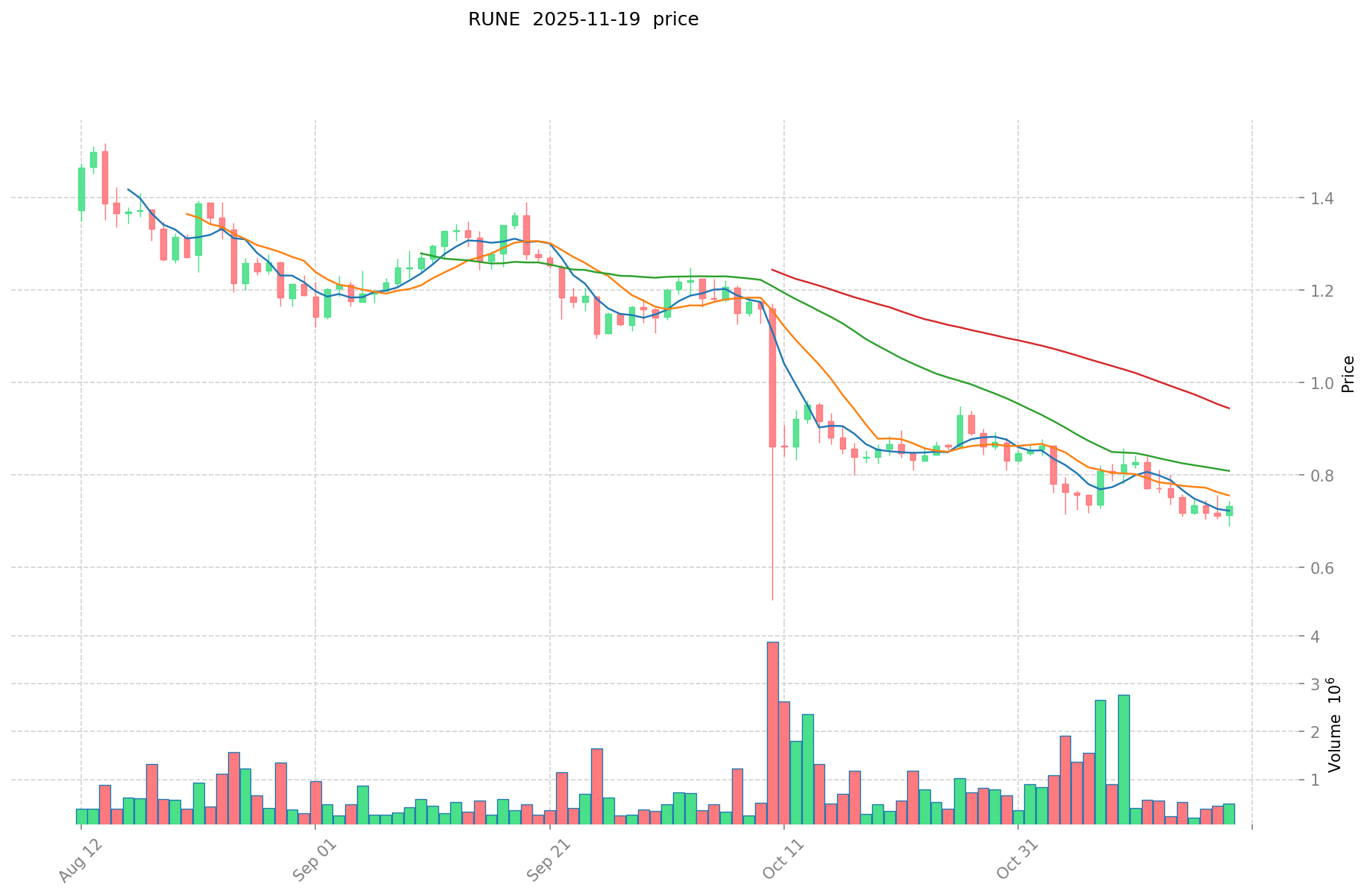HIGH vs RUNE: Unveiling the Epic Clash of Crypto Titans in DeFi Space
Introduction: Investment Comparison between HIGH and RUNE
In the cryptocurrency market, the comparison between Highstreet (HIGH) vs THORChain (RUNE) has been an unavoidable topic for investors. The two not only show significant differences in market cap ranking, application scenarios, and price performance, but also represent different positioning in the crypto asset space.
Highstreet (HIGH): Since its launch in 2021, it has gained market recognition for its open-world metaverse concept integrating shopping, gaming, and NFTs.
THORChain (RUNE): Introduced in 2019, it has been hailed as a highly optimized multi-chain platform, known for its cross-chain liquidity protocol.
This article will comprehensively analyze the investment value comparison between HIGH and RUNE, focusing on historical price trends, supply mechanisms, institutional adoption, technological ecosystems, and future predictions, attempting to answer the question most concerning to investors:
"Which is the better buy right now?"
I. Price History Comparison and Current Market Status
HIGH (Coin A) and RUNE (Coin B) Historical Price Trends
- 2021: HIGH reached its all-time high of $38.42 on December 17, 2021.
- 2021: RUNE hit its all-time high of $20.87 on May 19, 2021.
- Comparative analysis: In the recent market cycle, HIGH dropped from its all-time high of $38.42 to a low of $0.196752, while RUNE fell from $20.87 to $0.00851264.
Current Market Situation (2025-11-20)
- HIGH current price: $0.2281
- RUNE current price: $0.6836
- 24-hour trading volume: HIGH $30,474.90 vs RUNE $387,434.99
- Market Sentiment Index (Fear & Greed Index): 15 (Extreme Fear)
Click to view real-time prices:
- View HIGH current price Market Price
- View RUNE current price Market Price


RUNE Investment Value Core Factors
Cross-Chain Transaction Volume
- Primary Value Driver: The volume of native asset swaps on THORChain network directly impacts protocol revenue and RUNE demand
- Value Capture Mechanism: Higher transaction volume creates stronger demand for RUNE and enhances its value capture capability
- 📌 Historical Pattern: Transaction volume growth correlates strongly with RUNE price appreciation periods
Speculative Leverage Ratio
- Network Security Design: The ratio of RUNE market cap to non-RUNE TVL (Total Value Locked) ideally maintained at 3:1
- Protection Mechanism: For every $1 of non-RUNE value added to the network, $3 of RUNE must be locked
- Current Trend: This ratio has experienced continuous decline, indicating potential undervaluation
Technical Architecture & Protocol Development
- Unique Cross-Chain Solution: RUNE's distinctive technology provides seamless asset exchanges across multiple blockchains
- Zero-Interest Products: Protocol features include 0% interest loans, no liquidations, and no expiration periods
- Protocol Upgrades: Continued development of the THORChain ecosystem enhances utility and adoption potential
Community & Market Positioning
- Strong Community Support: Robust community backing provides foundation for long-term growth
- Market Potential: Despite market volatility and technical risks, RUNE demonstrates significant market potential
- Ecosystem Growth: The continuing development of the cross-chain ecosystem strengthens RUNE's position in the broader cryptocurrency landscape
III. 2025-2030 Price Prediction: HIGH vs RUNE
Short-term Prediction (2025)
- HIGH: Conservative $0.14 - $0.22 | Optimistic $0.22 - $0.29
- RUNE: Conservative $0.62 - $0.68 | Optimistic $0.68 - $0.89
Mid-term Prediction (2027)
- HIGH may enter a growth phase, with estimated prices of $0.20 - $0.33
- RUNE may enter a bullish market, with estimated prices of $0.92 - $1.19
- Key drivers: Institutional capital inflow, ETF, ecosystem development
Long-term Prediction (2030)
- HIGH: Base scenario $0.22 - $0.40 | Optimistic scenario $0.40 - $0.43
- RUNE: Base scenario $1.06 - $1.30 | Optimistic scenario $1.30 - $1.61
Disclaimer: This analysis is based on historical data and market projections. Cryptocurrency markets are highly volatile and unpredictable. This information should not be considered as financial advice. Always conduct your own research before making investment decisions.
HIGH:
| 年份 | 预测最高价 | 预测平均价格 | 预测最低价 | 涨跌幅 |
|---|---|---|---|---|
| 2025 | 0.29523 | 0.2271 | 0.140802 | 0 |
| 2026 | 0.33690285 | 0.261165 | 0.156699 | 14 |
| 2027 | 0.33790833525 | 0.299033925 | 0.2093237475 | 31 |
| 2028 | 0.3885347787525 | 0.318471130125 | 0.2547769041 | 39 |
| 2029 | 0.448948752137212 | 0.35350295443875 | 0.335827806716812 | 54 |
| 2030 | 0.433323921551019 | 0.401225853287981 | 0.220674219308389 | 75 |
RUNE:
| 年份 | 预测最高价 | 预测平均价格 | 预测最低价 | 涨跌幅 |
|---|---|---|---|---|
| 2025 | 0.894337 | 0.6827 | 0.621257 | 0 |
| 2026 | 1.174892565 | 0.7885185 | 0.66235554 | 15 |
| 2027 | 1.19768074965 | 0.9817055325 | 0.92280320055 | 43 |
| 2028 | 1.133280866718 | 1.089693141075 | 0.8935483756815 | 59 |
| 2029 | 1.48939258522131 | 1.1114870038965 | 0.68912194241583 | 62 |
| 2030 | 1.612545345253042 | 1.300439794558905 | 1.066360631538302 | 90 |
IV. Investment Strategy Comparison: HIGH vs RUNE
Long-term vs Short-term Investment Strategy
- HIGH: Suitable for investors focused on metaverse and gaming potential
- RUNE: Suitable for investors interested in cross-chain liquidity and DeFi infrastructure
Risk Management and Asset Allocation
- Conservative investors: HIGH 30% vs RUNE 70%
- Aggressive investors: HIGH 60% vs RUNE 40%
- Hedging tools: Stablecoin allocation, options, cross-currency portfolios
V. Potential Risk Comparison
Market Risk
- HIGH: Highly volatile due to its niche market in metaverse and gaming
- RUNE: Susceptible to overall DeFi market trends and cross-chain adoption rates
Technical Risk
- HIGH: Scalability, network stability, and metaverse platform development challenges
- RUNE: Cross-chain security, smart contract vulnerabilities, and network congestion issues
Regulatory Risk
- Global regulatory policies may impact both differently, with HIGH potentially facing scrutiny in virtual world regulations and RUNE in cross-chain transaction oversight
VI. Conclusion: Which Is the Better Buy?
📌 Investment Value Summary:
- HIGH advantages: Unique positioning in metaverse and gaming, potential for growth in emerging digital economies
- RUNE advantages: Strong cross-chain liquidity solution, established presence in DeFi, potential for wider blockchain ecosystem adoption
✅ Investment Advice:
- New investors: Consider a balanced approach with a slight bias towards RUNE due to its more established market presence
- Experienced investors: Explore a diversified portfolio including both HIGH and RUNE, adjusting based on risk tolerance and market trends
- Institutional investors: Focus on RUNE for its cross-chain infrastructure potential, while keeping an eye on HIGH for long-term metaverse exposure
⚠️ Risk Warning: The cryptocurrency market is highly volatile. This article does not constitute investment advice. None
VII. FAQ
Q1: What are the main differences between HIGH and RUNE? A: HIGH is focused on the metaverse and gaming sector, while RUNE is a cross-chain liquidity protocol. HIGH has potential in emerging digital economies, whereas RUNE offers established DeFi infrastructure and cross-chain solutions.
Q2: Which coin has shown better price performance historically? A: Both coins have experienced significant price drops from their all-time highs. HIGH fell from $38.42 to $0.2281, while RUNE dropped from $20.87 to $0.6836. RUNE has maintained a higher current price despite the market downturn.
Q3: What are the key factors driving RUNE's investment value? A: RUNE's value is primarily driven by cross-chain transaction volume, its speculative leverage ratio, technical architecture, protocol development, and strong community support.
Q4: How do the 2030 price predictions compare for HIGH and RUNE? A: For 2030, HIGH is predicted to reach $0.22 - $0.43, while RUNE is forecasted to reach $1.06 - $1.61 in the optimistic scenario.
Q5: What are the main risks associated with investing in HIGH and RUNE? A: HIGH faces risks related to market volatility in the metaverse sector and technical challenges in platform development. RUNE's risks include cross-chain security issues, smart contract vulnerabilities, and potential regulatory scrutiny of cross-chain transactions.
Q6: How should investors allocate their portfolio between HIGH and RUNE? A: Conservative investors might consider allocating 30% to HIGH and 70% to RUNE, while aggressive investors could opt for 60% HIGH and 40% RUNE. The exact allocation should be based on individual risk tolerance and market analysis.
Q7: Which coin is considered a better buy for different types of investors? A: New investors might lean towards RUNE due to its established market presence. Experienced investors could consider a balanced portfolio of both. Institutional investors may focus on RUNE for its cross-chain infrastructure potential while keeping HIGH for long-term metaverse exposure.
Share
Content